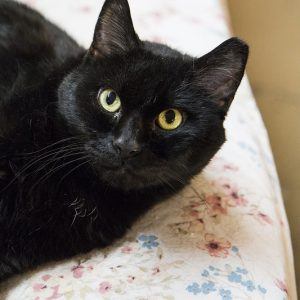Busting Myths on Black Cat Appreciation Day
By epetsure
August 17th is the annual Black Cat Appreciation Day! Black cats tend to get a bad rap for a variety of false and downright weird reasons. In the past few years something called Black Cat Syndrome has been circulating around the internet, the belief that animals with darker fur are adopted less frequently. This is just one of the myths and misperceptions people have about these animals – get ready to forget everything you knew about black cats.
1. Black Cat Syndrome is not a thing.
It sounds legit and even has an official-sounding name, but the logic behind Black Cat Syndrome does not hold up. For decades shelters have faced legions of black cats and dogs who struggle to find forever homes. A Telegrapharticle published last year tried to blame the “selfie age,” saying black cats don’t photograph as well. This led to outrage from pet parents, who promptly posted billions of photos using #blackcatselfie to prove critics wrong.
Dr. Emily Weiss writes about Black Cat Syndrome at least once a year, by popular demand. In a 2013 blog post for ASPCA Professional, she describes several studies of Black Dog Syndrome where participants rated a variety of dog breeds and colors on their friendliness. The black Lab was considered less hostile and more friendly than other breeds in one study, while in another black poodles were seen as “significantly more friendly” than their white counterparts. Dr. Weiss chalks this up to how humans stereotype dog breeds – white poodles are yappy and mean, while Black labs are family dogs.

There’s one more crucial fact in the fight against Black Cat Syndrome and it’s a doozy. Using the Comprehensive Animal Risk Database (CARDS), Dr. Weiss discovered black cats (and dogs) make up the majority of incoming shelter animals, roughly 30 percent. “There are simply more black dogs and cats entering the system, making it appear that they are more at risk,” says Dr. Weiss. “Let’s say 4 black dogs and 1 white dog enter the shelter, and the next day 1 white dog and 1 black dog are adopted – that leaves just three black dogs in kennels, shifting a perception of risk. However, the same number of black and white dogs were adopted!” Unsurprisingly, black cats are also the most likely to be adopted – and also to be euthanized – making the myth of Black Cat Syndrome officially busted.
2. Black cats are too photogenic!
We mentioned the #blackcatselfie movement before, but this misconception comes from shelters, who heavily rely on photographs to promote adoptable animals online. Whether due to time and budget constraints or lack of photography knowledge, many rescue groups are forced to display low quality photographs, even using cell phones. This contributes to the perception of black cats as “unphotogenic.”
It’s ridiculous to say that a black cat can’t take a good photo – that’s what flash is for! If you’re having difficulty photographing your feline, try moving yourself to where the light is. Catch kitty in direct sunlight, especially in the early morning or during the golden hour, for the best lighting. iPhone photographers should “tap to focus” on the lightest part of the subject, like the eyes or a white patch of fur.
3. You make your own luck – don’t blame black cats.
It may seem silly, but old-fashioned superstitions die hard. Throughout much of the world black cats are seen as an omen of bad luck. Black cats have also been associated with witchcraft, anarchism and the devil. Maybe it’s because their (thick and fluffy) black fur makes them virtually invisible in the dark, except for their luminous green or yellow eyes. Whatever the reason, it’s obviously false that black cats cause back luck. In fact, some cultures – including British and Japanese – having one cross your path is good luck.
Black cats’ color can become a safety hazard, which would make it seem like they have bad luck. A black cat is nearly impossible to see at night, making him vulnerable to passing cars. (Another reason to keep kitty inside!) Cats are also notorious for tripping up pet parents, especially at night. But for the record, dogs are responsible for 7.5 times more pet parent injuries! Try putting a jingle bell or reflective collar on your cat to increase visibility at night.

4. Black cats do not all look the same.
A common complaint is that you can’t tell one black cat from another – there are no distinctive markings on all-black cats. Some shelters say this is a problem, especially with kittens. We argue that every cat is unique! No two shades of black fur are the same; direct sunlight reveals hidden tabby patterns, silver or gold tips, and “rusting.” Some shelter cats have ear notches or scars, or very distinctive ears or whiskers. Most of all, black cats have very different personalities – find the feline that fits your family!
Poor quality photos may make cats’ identities hard to discern, but you should never rely on a shelter’s description before adopting a pet. Always visit your potential pet in person before making the final decision, even if you have to fly or drive out of state. Before joining your fur family, a new cat must meet all existing pets and get their okay.
This content is provided by Healthy Paws Pet Insurance. The #1 customer-rated Healthy Paws plan reimburses you for up to 90% of vet bills for accidents or illness. With every free quote for dog insurance or cat insurance, Healthy Paws makes a donation toward a homeless pet’s medical care. Learn more at Healthy Paws Pet Insurance.com.




